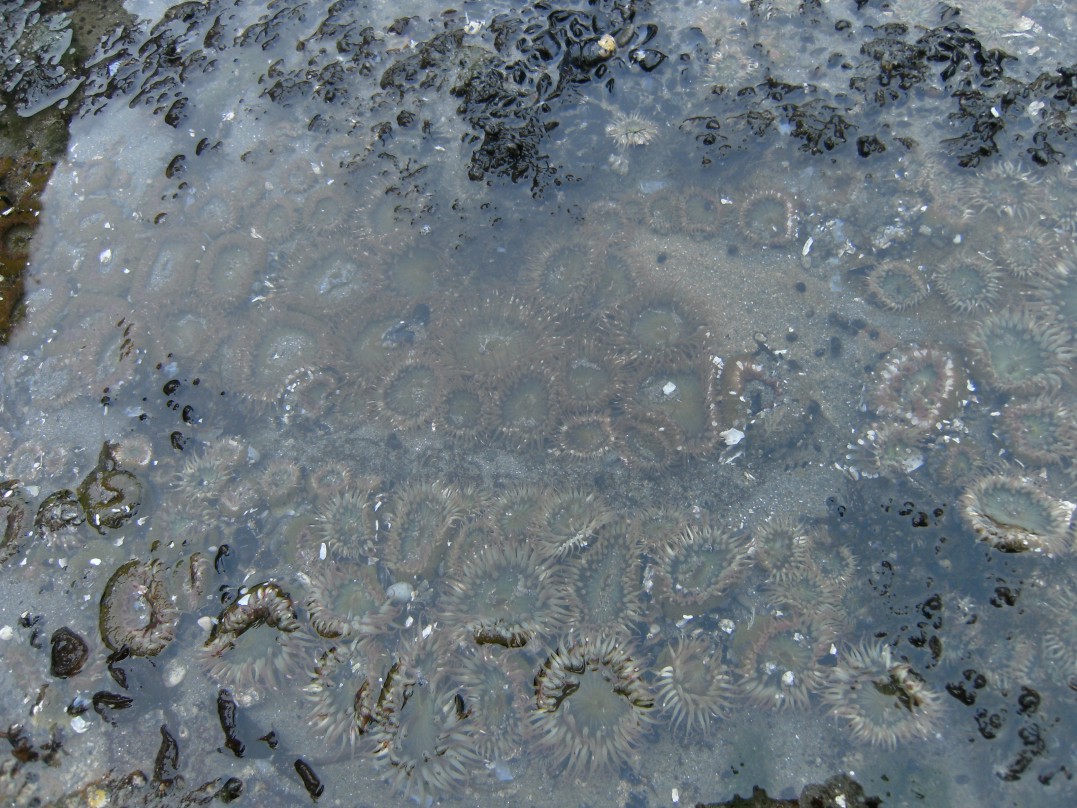Anthopleura elegantissima (Brandt, 1835)Common name(s): Aggregating Anemone, Green aggregating anemone |
|
| Synonyms: Cribrina elegantissima,
Bunodactis elegantissima |
 |
| Phylum Cnidaria
Class Anthozoa Subclass Zoantharia Order Actniniaria Family Actiniidae |
|
| Anthopleura elegantissima in lab, beginning to divide. The small individual above it has mesenteries partly protruding from its mouth. Width of oral disk of largest (dividing) anemone 5 cm | |
| Photo by: Dave Cowles 4-2005 | |
How to Distinguish from Similar Species: : It is similar to Anthopleura xanthogrammica, which is all green. A. elegantissima almost always have pinkish tips on their tentacles, and in the Pacific Northwest are usually smaller in size. Anthopleura artemisia has verrucae on only the top 2/3 of its column and usually lives mostly buried in sand. Anthopleura sola, which was formerly known as the solitary form of A. elegantissima, is very similar except that it is solitary and usually larger. It was distinguished from A. elegantissima by molecular means.
Geographical Range: From Alaska all the way down to Baja California.
Depth Range: Live in the intertidal zone.
Habitat: Can be found either in dense populations or solitary, on rock walls, boulders, or pilings from between high- and low-tide lines to low-tide line. Prefers to live in semiprotected areas near the outer coast.
Biology/Natural History: Background color is due in part to zooxanthellae and zoochlorellae living symbiotically in the gastrodermal layer. (see below photo) Both are able to live in the anemone at the same time. They are able to transfer carbon to their host, the anemone. Its possible that the anemone can control the numbers of algal cells that it has by expelling them in a bolus of mucus. The species can handle a high range of temperatures, but the higher temperatures do affect the number and perhaps eventually type of symbiotic algae. The anemones tend to eat barnacle molts, dead debris from plankton, and mussels that have fallen off the overhead rocks. Anemones of this species frequently divide asexually by expanding the base of their column in two directions until they tear in half (picture). Large clusters, or aggregations, of clonally related anemones come to dominate areas of the intertidal in this way (photo). The aggregating anemones have an aggressive behavior towards other anemones that are not clones of themselves, (see photo below) and maintain anemone-free areas between clones (photo). They do sexually reproduce to disperse to new habitats. The verrucae frequently are holding bits of shell or gravel (photo) which is thought to provide some protection from ultraviolet light and/or reduce desiccation. Predators include the seastar Dermasterias imbricata, the nudibranch Aeolidia papillosa, and the wentletrap snail Epitonium tinctum.
Asexual division is especially common in January to March (Hand, 1955)
This anemone may harbor either zooxanthellae (dinoflagellate) or zoochlorellae (chlorophyte) intracellular symbionts. In California, the zooxanthellae may be either Symbiodinium californium or S. muscatinei. In Oregon and Washington the only zooxanthellae symbionts are S. muscatinei. Anemones with zooxanthellae have been observed from Baja California to SE Alaska, but are more common from Washington south. Anemones with zoochlorellae occur from Cape Blanco, Oregon north at least to Vancouver Island. The zoochlorella has recently been identified as Elliptochloris marina. In areas where both symbionts occur, anemones with zooxanthellae can be found throughout the intertidal but favor the upper levels, while anemones with zoochlorellae are primarily found in the lower intertidal or in shaded areas. This trend persists through the year, even though anemones appear to be able to change symbionts and many anemones contain a mixture of the two symbionts. The most rapid division of the algal symbionts occurred in July and November (Dimond et al., 2011)
Anthopleura elegantissima contains these types of cnidae: Spirocysts, atrichs, basitrichs, and microbasic p-mastigophores.
Predators include the nudibranchs Aeolidia papillosa
and Aeolidia
loui
| Return to: | |||
| Main Page | Alphabetic Index | Systematic Index | Glossary |
References:
Dichotomous Keys:Allen, 1976
Carlton, 2007
Kozloff 1987, 1996
Smith and Carlton, 1975
General References:
Morris
et al., 1980.
O’Clair
and O’Clair, 1998.
Scientific Articles:
Dimond, J.L.,
B.L. Bingham, G. Muller-Parker, K. Wuesthoff, and L. Francis, 2011.
Seasonal stability of a flexible algal-cnidarian symbiosis in a highly
variable temperate environment. Limnology and Ocranography 56:6 pp.
2233-2242
Engebretson, H.P, and G. Muller-Parker, 1999. Translocation of photosynthetic carbon from two algal symbionts to the sea anemone Anthopleura elegantissima. Biological Bulletin 197: 72-81
Grimmelikhuijzen, Cornelis J.P., Klaus Carstensen, Dorothea Darmer, Angelika moosler, Hans-Peter Nothacker, Rainer K. Reinscheid, Cornelia Schmutzler, and Henning Vollert, 1992. Coelenterate neuropeptides: structure, action and biosynthesis. American Zoologist 32: pp. 1-12
Francis, Lisbeth, 1979. Contrast between solitary and clonal lifestyles in the sea anemone Anthopleura elegantissima. American Zoologist 19: 669-681
Harris, Larry G. and Nathan R. Howe, 1979. An analysis of the defensive mechanisms observed in the anemone Anthopleura elegantissima in response to its nudibranch predator Aeolidia papillosa. Biological Bulletin 157: pp. 138-152
Hand, Cadet, 1955. The sea anemones of central California part II. The endomyarian and mesomyarian anemones. The Wasmann Journal of Biology 13:1 pp. 37-99
LaJeunesse, T.C., and R.K. Trench, 2000. Biogeography of two species of Symbiodinium (Freudenthal) inhabiting the intertidal sea anemone Anthopleura elegantissima (Brandt). Biological Bulletin 199: 126-134
Lewis, L. L. and G. Muller-Parker, 2004. Phylogenetic placement of "zoochlorellae" (Chlorophyta), algal symbiont of the temperate sea anemone Anthopleura elegantissima. Biological Bulletin 207: 87-92
McCloskey, L.R., T.G. Cove, and E.A. Verde, 1996. Symbiont expulsion from the anemone Anthopleura elegantissima (Brandt) (Cnidaria; Anthozoa). J. Exp. Mar. Biol. Ecol. 195: 173-176
McFadden, C.S., R.K. Grosberg, B. B. Cameron, D. P. Karlton, and D. Secord, 1997. Genetic relationships within and between clonal and solitary forms of the sea anemone Anthopleura elegantissima revisited: evidence for the existence of two species. Marine Biology 128: 127-139
Saunders, B.K. and G. Muller-Parker, 1997. The effects of temperature and light on two algal populations in the temperate sea anemone Anthopleura elegantissima (Brandt, 1835). J. Exp. Mar. Biol. Ecol. 211: 213-224
Sebens, K.P., 1977. Habitat suitability, reproductive ecology and the plasticity of body size in two sea anemone populations. Ph.D. Dissertation, University of Washington.
Secord, D. L., and L. Augustine, 2000. Biogeography and microhabitat variation in temperate algal-invertebrate symbioses: Zooxanthellae and zoochlorellae in two Pacific intertidal sea anemones, Anthopleura elegantissima and A. xanthogrammica. Invertebrate Biology 119: 139-146
Secord, David and Gisele Muller-Parker, 2005. Symbiont distribution along a light gradient within an intertidal cave. Limnology and Oceanography 50:1 272-278
Smith, B.L. and D.C. Potts, 1987. Clonal and solitary anemones (Anthopleura) of western North America: population genetics and systematics. Marine Biology 94: 537-546
Verde, E.A. and L. R. McCloskey, 1996a. Carbon budget studies of symbiotic cnidarian anemones--evidence in support of some assumptions. J. Exp. Mar. Biol. Ecol. 195: 161-171
Verde, E.A. and L.R. McCloskey, 1996b. Photosynthesis and respiration of two species of algal symbionts in the anemone Anthopleura elegantissima (Brandt) (Cnidaria; Anthozoa). J. Exp. Mar. Biol. Ecol. 195: 187-202
Verde, E.A. and L. R. McCloskey, 2001. A comparative analysis of the photobiology of zooxanthellae and zoochlorellae symbiotic with the temperate clonal anemone Anthopleura elegantissima (Brandt). I. Effect of temperature. Mar. Biol. 138: 447-489
Verde, E.A. and L. R. McCloskey, 2002. A comparative analysis
of the photobiology of zooxanthellae and zoochlorellae symbiotic with the
temperate clonal anemone Anthopleura elegantissima (Brandt).
II. Effect of light intensity. Mar. Biol. 141: 225-239
General Notes and Observations: Locations, abundances, unusual behaviors, etc.:
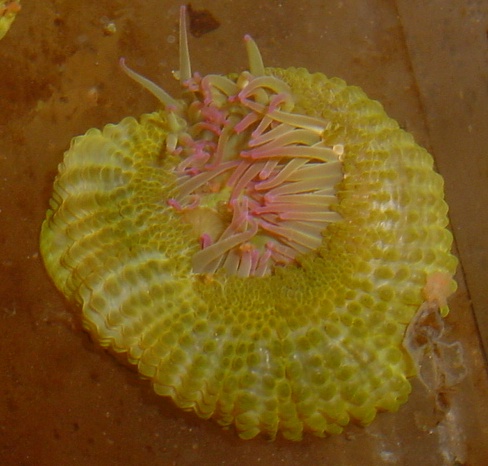 |
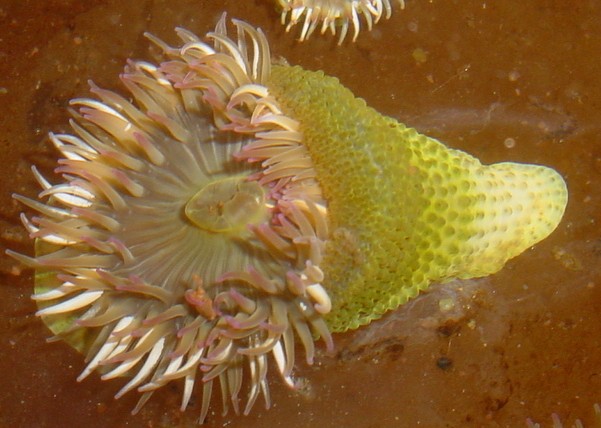 |
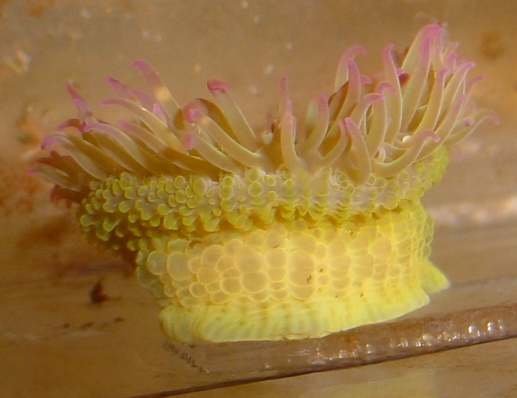 |
The three photos above and at left show some variations on the distribution
of green color and the pattern of tubercles (verrucae)
on the column of
Anthopleura elegantissima.
Photos by Dave Cowles in lab, April 2005 |

This large individual, wedged between intertidal boulders at Seal Beach,
OR, shows how the verrucae
are often arranged in vertical rows. Photo by Dave Cowles, Sept 2010.
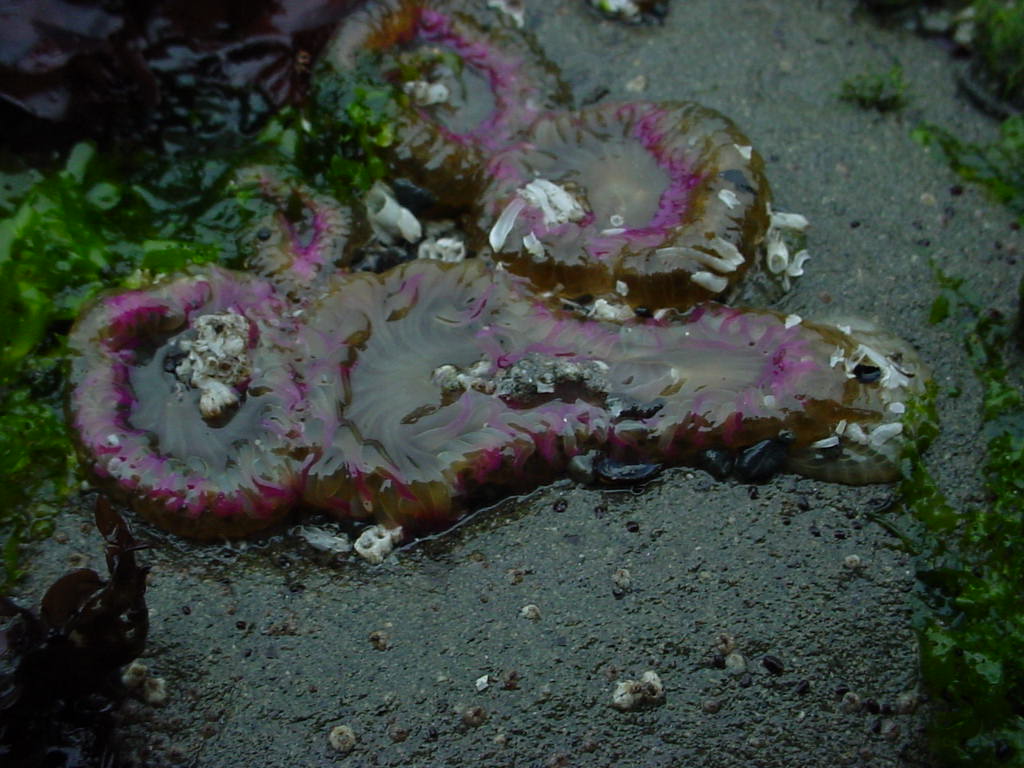
The Anthopleura elegantissima at the bottom right of this photo
has nearly completed dividing. The individual at the bottom left
is probably part of the same clone because the anemones are touching each
other without fighting. Photo by Dave Cowles, Beach #4, Olympic Peninsula
Sequence of the final stages of Anthopleura elegantissima dividing in the laboratory. |
 |
| This individual, in the lab, is near the final stages of dividing. Its length is 8 cm and its width is 2 cm. Time: 9 am on Nov 10, 2006 |
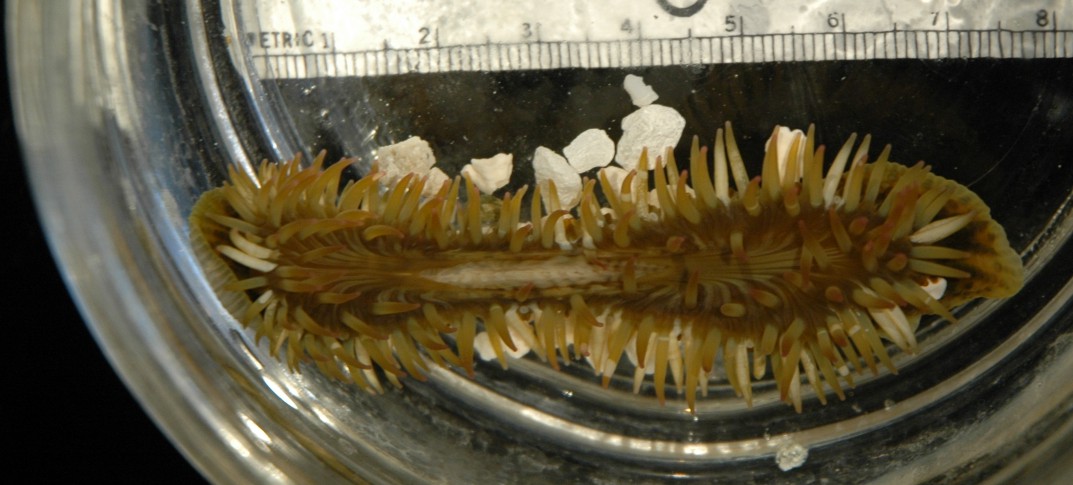 |
| By 2 hours later, 11 am, the stretching is even more prominent. |
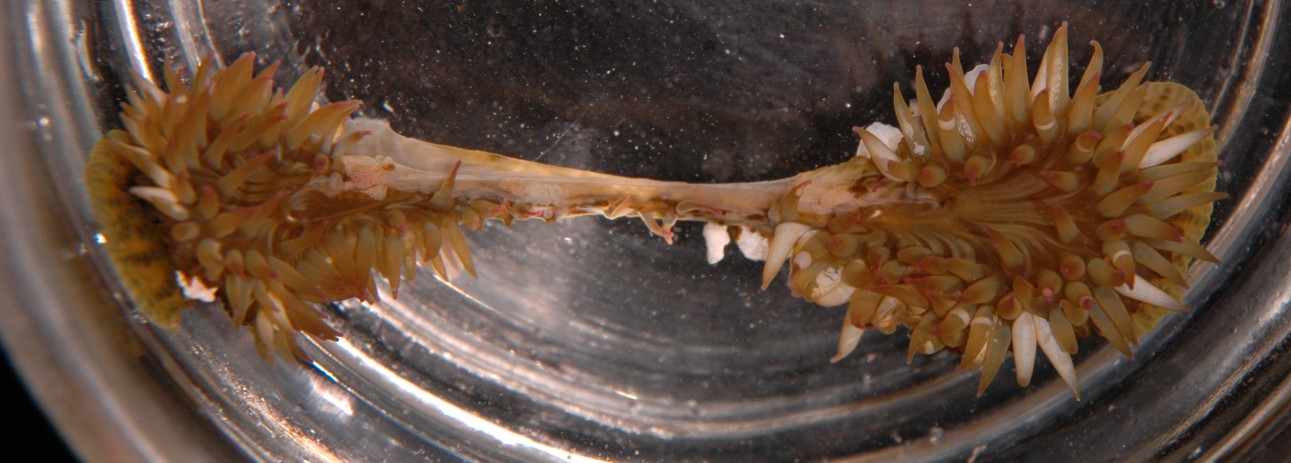 |
| Final separation is slow, at least for this individual. This photo is from 3 days later, Nov 13 at 2 pm |
| For a time-lapse movie of the final stages of the division click here. The movie is speeded up 120x over real time. |

This is a photo of two A elegantissima or
A.
sola fighting with acrorhagi"
attack tentacles".
Taken at San Simeon, CA by Dave Cowles in a tidepool.
Click here
to see a time-lapse video produced by Faith Morales in 2023, speeding up
1 round (about 21 minutes, with 1 frame every 30 seconds) of a similar
fight using acrorhagi
between two anemones in the lab.
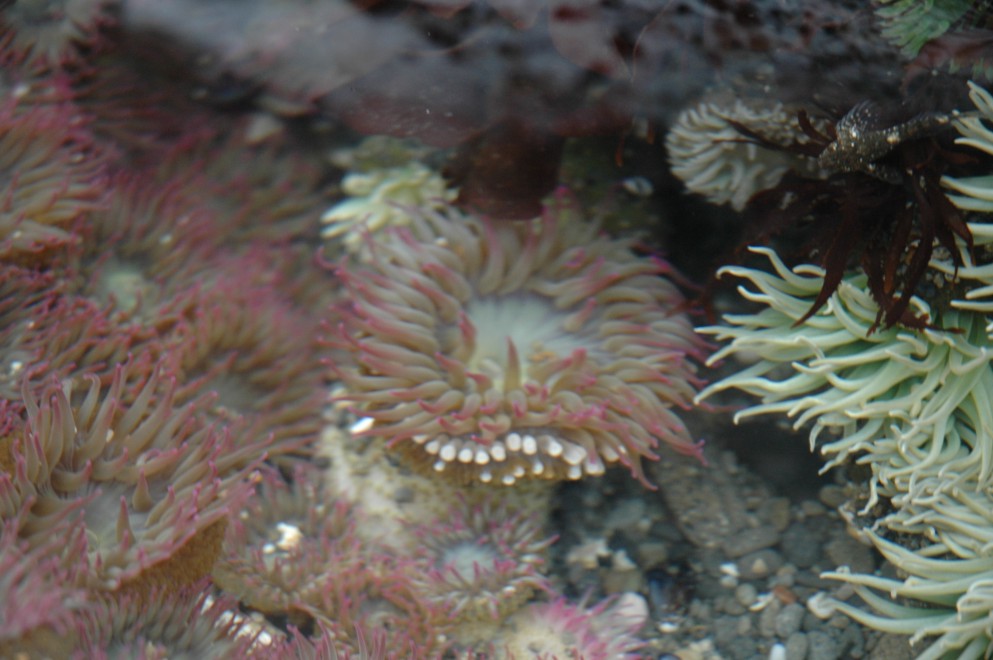
Here is another individual with its white acrorhagi
extended. Other A. elegantissima
are visible at the left, and A.
xanthogrammica can be seen to the right.
Photo by Dave Cowles at Kalaloch Beach #4, Olympic Peninsula.
July 2006
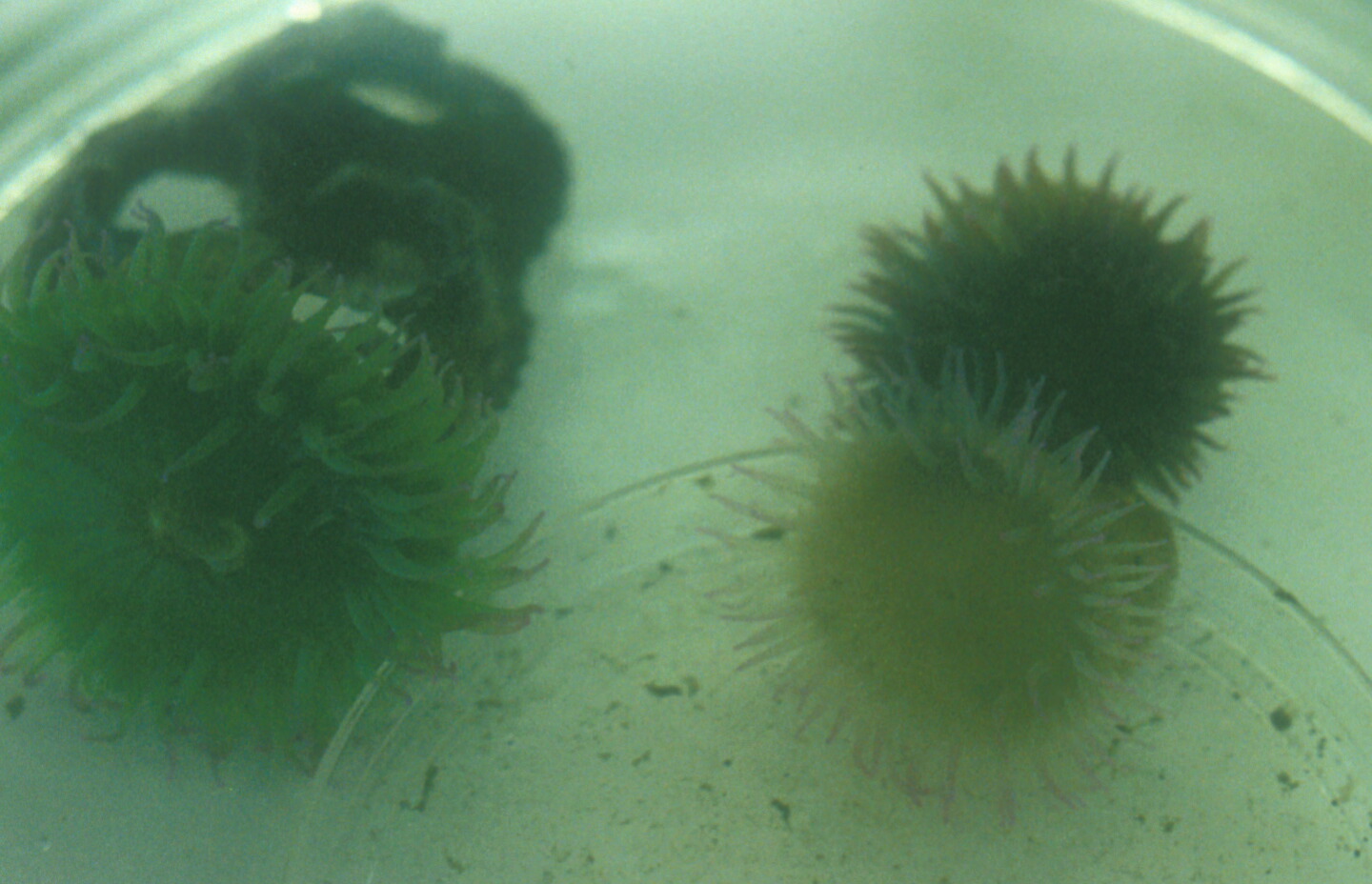
The A. elegantissima on the left has zoochlorellae
(green algae) as symbionts, that on the right has zooxanthellae.
Taken at Rosario Beach Marine Laboratory by Dave Cowles, 2001
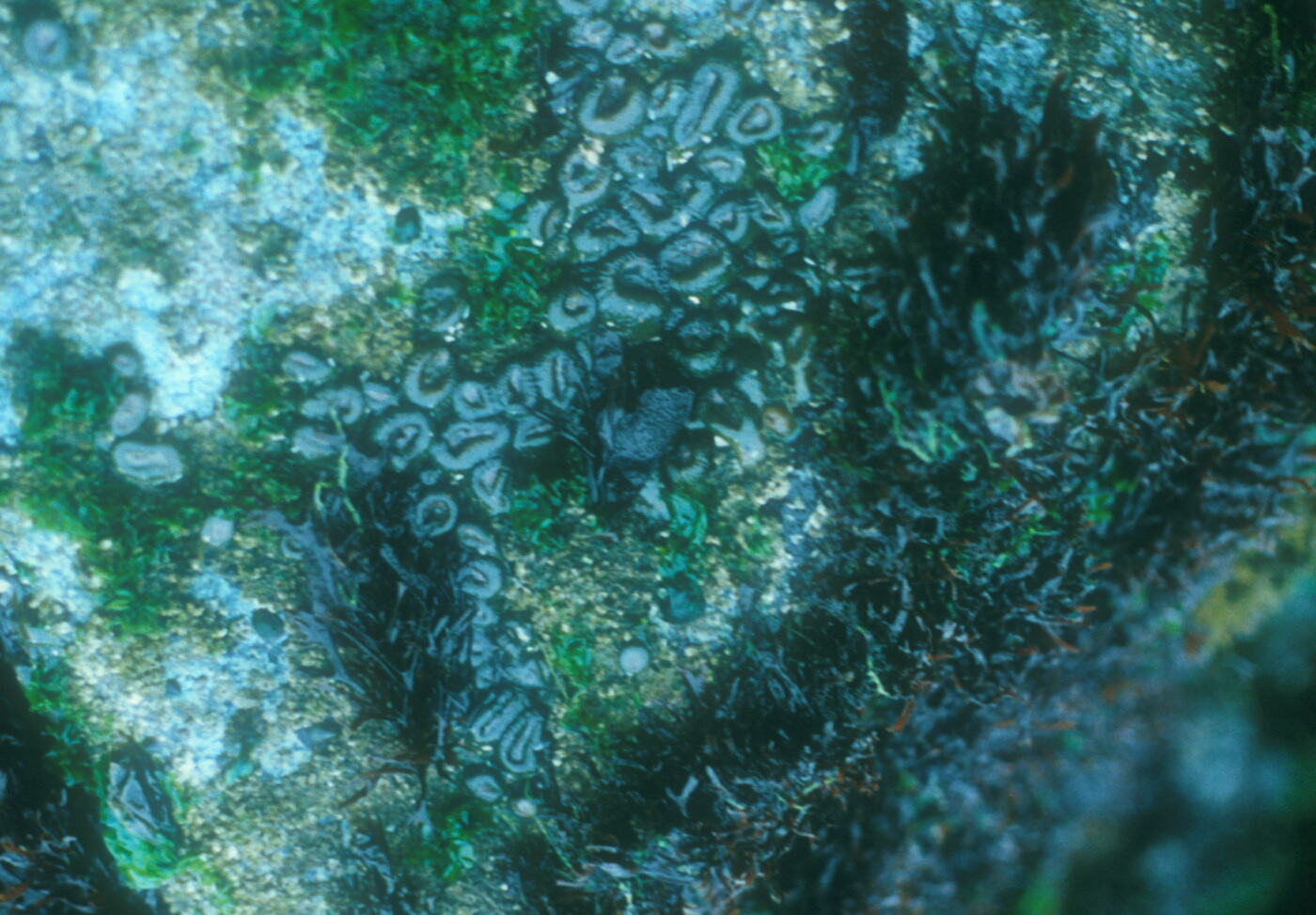
A clone of A elegantissima anemones at Moss Landing, Ca.
Photo by Dave Cowles 1998
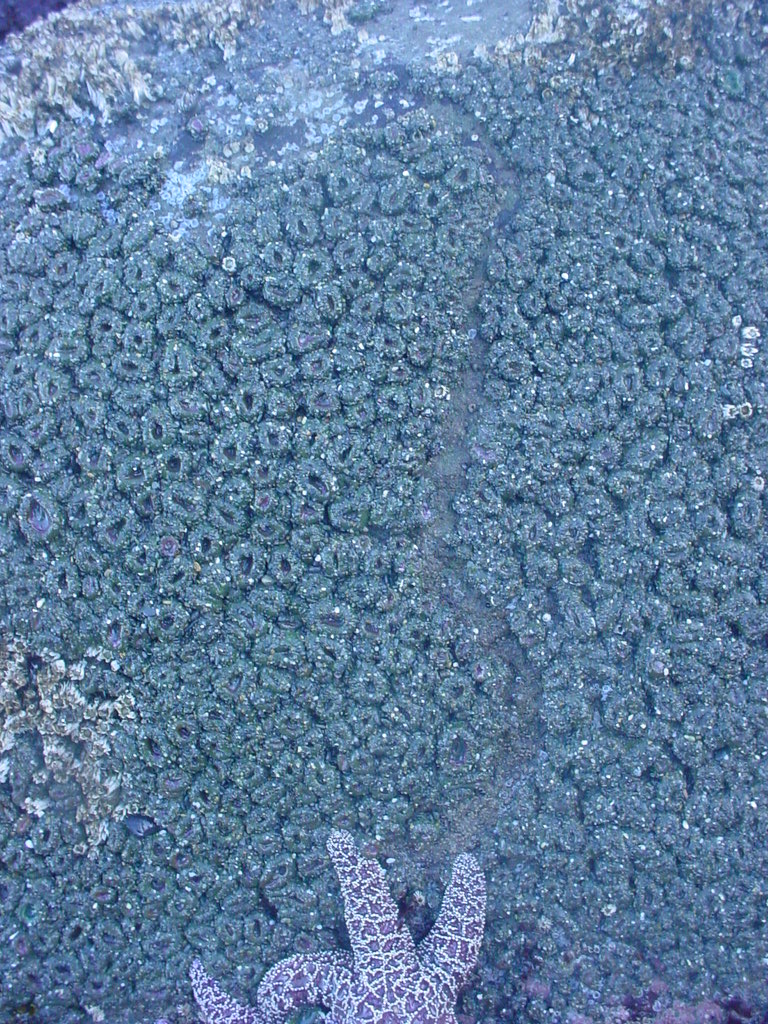
The border between different clones is often visible as a bare line,
as in this photo from Beach #4, Olympic National Park.
Photo by Dave Cowles, July 2004
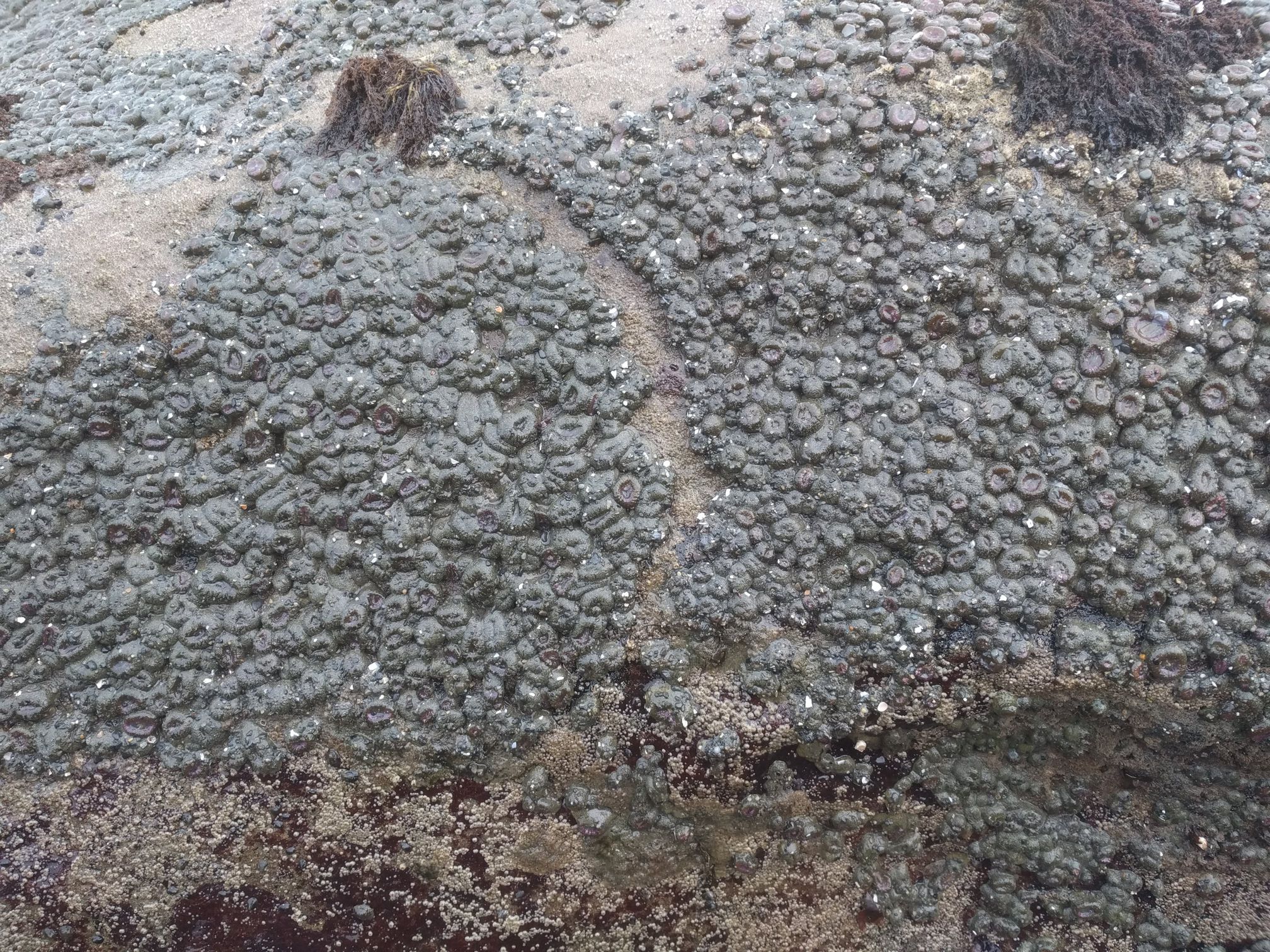
Another "clone line" between two clones of anemones. Photo taken at
Kalaloch Beach #4 by Dave Cowles, July 2019
Several clones in this tidepool, each of which looks slightly different, are separated by a bare, unoccupied line. Several individuals along the margins have white attack tentacles (acrorhagi) exposed. Photo by Dave Cowles, Beach #4, July 2012

This clone, covered with bits of gravel and shell which they hold onto
by their verrucae,
is at Little Corona del Mar, CA. Photo by Dave Cowles, March 2005
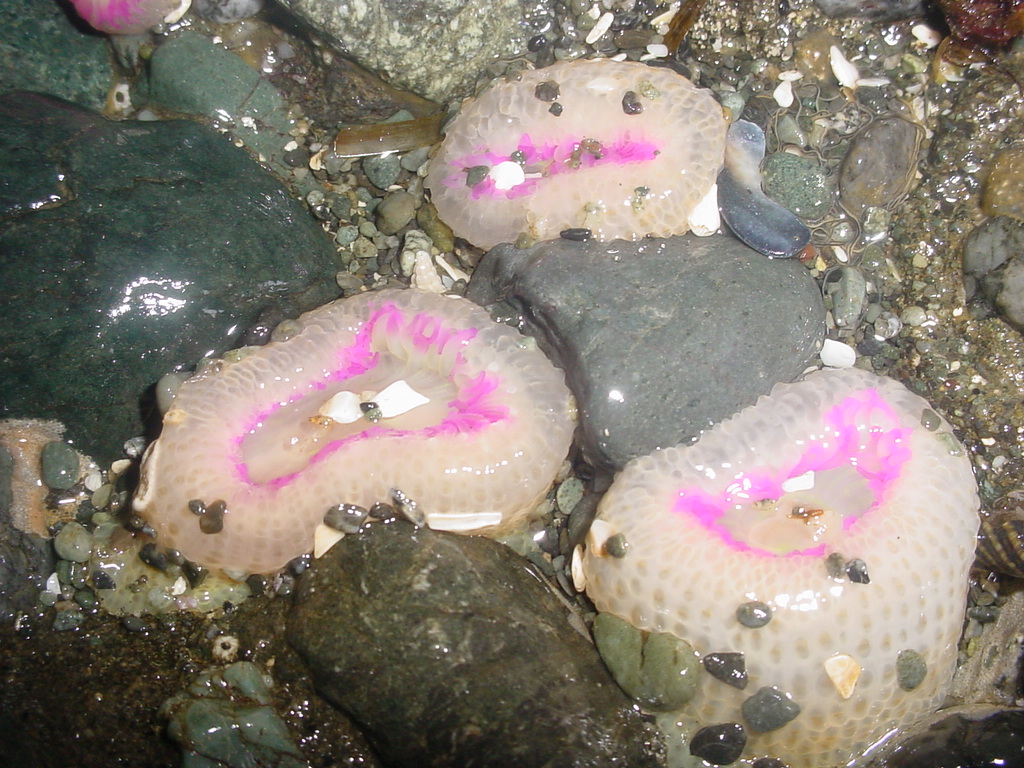
When in low light conditions A. elegantissima loses its algae
and becomes aposymbiotic,
as in these specimens from a sea cave. Situations such as this show
clearly that the normal green coloration in the anemone is from the algal
symbiont, not from the animal itself. Photo by Dave Cowles, July 2005

These anemones were living in holes in a partially sand-covered rock
at Kalaloch, Olympic Peninsula, WA. Photo by Dave Cowles, July 2005
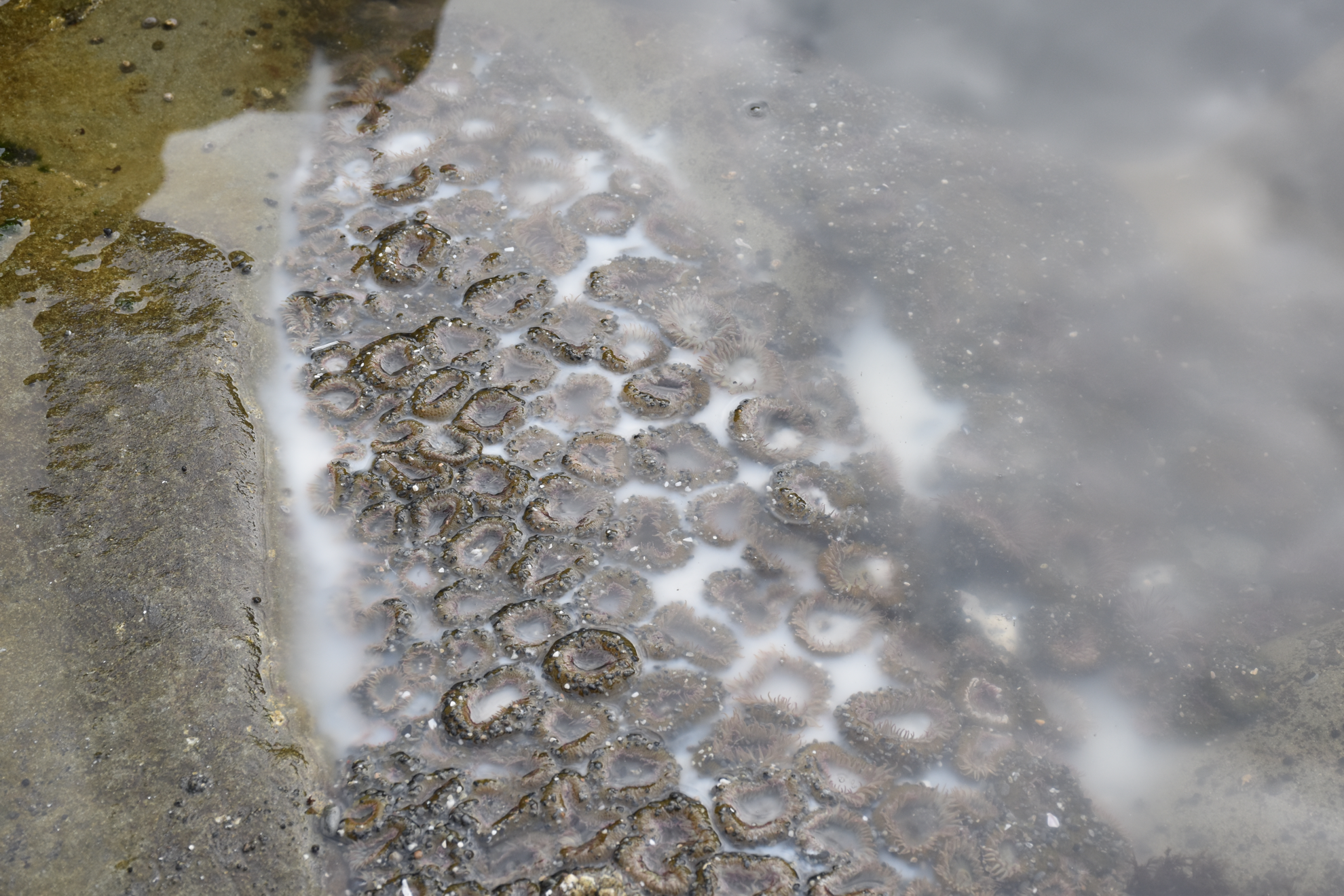
These large A. elegantissima
in a tidepool at Beach #4 at Kalaloch, WA release sperm on July 16, 2021.
Photo by Dave Cowles
Authors and Editors of Page:
Brandon White, creator of original page. 8-2002.
Edited by Hans Helmstetler 12-2002
Edited by Dave Cowles 2004, 2005
